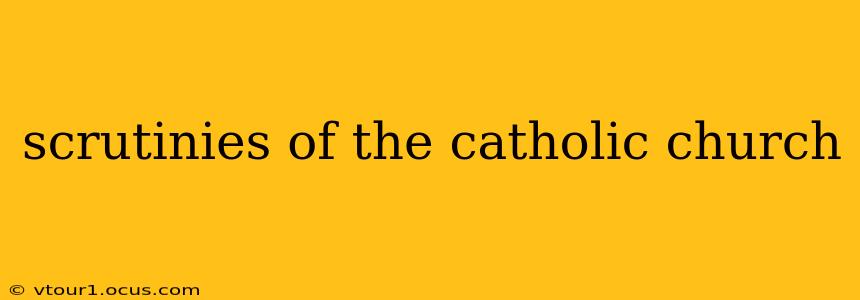The Catholic Church, as one of the world's oldest and largest institutions, has faced numerous scrutinies throughout its history. These examinations range from theological debates and internal reforms to external criticisms regarding its doctrines, practices, and historical actions. Understanding these scrutinies requires a nuanced perspective, acknowledging both the Church's efforts towards self-improvement and the ongoing challenges it faces in the 21st century.
What are the main criticisms of the Catholic Church?
The Catholic Church has faced a wide array of criticisms across centuries. Some of the most prominent include:
- Doctrinal rigidity: Critics often point to the Church's seemingly inflexible stances on issues like abortion, contraception, and same-sex marriage as out of touch with modern values and scientific advancements. The perceived lack of willingness to adapt to evolving societal norms is a frequent point of contention.
- Historical abuses: Perhaps the most significant and damaging criticisms center around historical instances of abuse, particularly the widespread sexual abuse of children by clergy. The Church's handling (or mishandling) of these cases, often involving cover-ups and transfers of abusive priests, has severely eroded public trust.
- Treatment of women: The Church's traditional hierarchical structure, which largely excludes women from positions of power and authority, faces ongoing criticism from feminists and others advocating for gender equality. The exclusion of women from the priesthood is a particularly contentious issue.
- Financial practices: Concerns about the Church's vast financial wealth and its management have been raised repeatedly. Questions regarding transparency, accountability, and the allocation of resources often arise.
- Colonialism and its legacy: The Church's role in the colonization of various parts of the world, often involving the suppression of indigenous cultures and religions, is another area of ongoing scrutiny. The lasting impacts of these actions continue to be debated and addressed.
- Inquisition and intolerance: The historical actions of the Inquisition, characterized by persecution and suppression of dissenting views, remain a stark reminder of past intolerance. While the Church has condemned such practices, the legacy continues to cast a shadow.
How has the Catholic Church responded to these criticisms?
The Church's response to these criticisms has been varied and, at times, inconsistent. While it has undertaken significant reforms, particularly in addressing sexual abuse, critics argue that these efforts are insufficient and often too slow.
- Internal reforms: The Church has established commissions and undertaken internal investigations to address sexual abuse and promote greater transparency. However, the effectiveness and reach of these reforms remain debated.
- Dialogue and engagement: Efforts have been made to engage in interfaith dialogue and promote understanding between different religious groups. However, the pace of these efforts is often seen as slow, and the perceived rigidity in core doctrines remains a barrier to significant progress.
- Apologies and acknowledgements: In recent years, there has been a greater willingness on the part of Church leaders to offer apologies for past wrongs and acknowledge the harm caused by institutional actions. This has, however, been met with mixed reactions, with some feeling the apologies are insufficient or insincere.
What are the future challenges for the Catholic Church?
The Catholic Church faces a complex set of challenges in the 21st century:
- Maintaining relevance in a secularizing world: As societies become increasingly secular, the Church must find ways to remain relevant and engaging to younger generations who may hold different values and beliefs.
- Addressing ongoing issues of abuse: Continued vigilance and proactive measures are essential to preventing future instances of abuse and ensuring accountability for those responsible.
- Promoting gender equality: Further steps towards greater inclusion and equality for women within the Church are vital to enhance its moral authority and credibility.
- Improving financial transparency: Increased transparency and accountability in financial practices are necessary to rebuild trust and address lingering concerns.
How does the Catholic Church justify its teachings?
The Catholic Church primarily justifies its teachings through its interpretation of scripture, tradition, and reason. These three pillars form the basis of its theological framework, guiding its moral and ethical stances. However, the interpretation of these pillars is often subject to debate and scrutiny, leading to differing perspectives within the Church itself and significant divergence with those outside of it.
What role does the Pope play in addressing these criticisms?
The Pope, as the head of the Catholic Church, plays a crucial role in shaping the Church's response to criticisms. His pronouncements and actions carry significant weight, impacting the Church's public image and its internal direction. While recent Popes have acknowledged past wrongs and initiated reforms, the pace and scope of change remain a subject of ongoing debate and scrutiny.
The scrutiny of the Catholic Church is an ongoing and multifaceted process. Understanding this requires a careful examination of its history, its teachings, and its ongoing efforts to address its challenges. The future of the Church will largely depend on its ability to engage with these criticisms constructively and demonstrate a genuine commitment to transparency, accountability, and meaningful reform.
